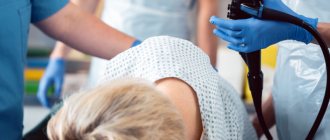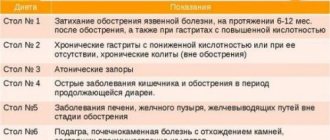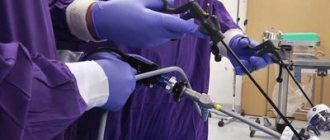There are contraindications. Specialist consultation is required.
Causes and symptoms Diagnosis and preparation Appendectomy Laparoscopic removal Recovery
The appendix is a vermiform appendix of the cecum, located between the small and large intestines. Its length in humans is 5-15 cm, diameter -1 cm. It is believed that its function is to protect the small intestine from bacteria living in the cecum. In the event of an inflammatory process (appendicitis), immediate removal of the entire appendix is indicated.
The essence of the operation on the appendix is to excise the inflamed appendix of the cecum and remove it through a small incision on the right side.
Causes and symptoms
Doctors identify a number of reasons that can lead to inflammation of the appendix:
- bends of the appendix, its increased mobility;
- blockage of the appendix with undigested parts of food or constipation;
- infectious or inflammatory process in the intestines;
The development of inflammation occurs gradually: first the appendix swells, then begins to fill with pus. Without removal, after two to three days the appendix ruptures and pus leaks into the abdominal cavity, causing peritonitis. This condition can lead to the death of the patient. The main symptom of appendicitis is pain in the abdomen: first in the upper part, then the pain is localized in the lower right part. Sometimes the patient may experience pain in the right hypochondrium, radiating to the back or anus. Other symptoms of the disease:
- increased pain when pressing on the abdomen;
- abdominal muscle tension;
- nausea and vomiting;
- change in bowel habits (constipation or diarrhea);
- temperature increase.
Senko Vladimir Vladimirovich
Leading surgeon oncologist at SM-Clinic. Doctor of the highest category.
Deputy Chief Physician for Surgery.
Head of the surgical hospital "SM-Clinic".
“During laparoscopic surgery, instruments are inserted into the abdominal cavity through pinhole punctures on the anterior abdominal wall. Usually, 3 punctures up to 1 cm long are enough. A video camera is inserted into one of them so that the surgeon can see the progress of the operation on the monitor. Sometimes, at the beginning of the operation, factors are discovered that prevent it from being performed laparoscopically. Then an open appendectomy is performed.”
Kinds
Patients experience the stage of scarring and restoration of the skin differently. Therefore, the site from the incision during appendicitis surgery appears in each person of a different size and shape, and it takes a different period of time to heal.
- Normotrophic – type of scar: the simplest, pale, invisible. Externally it does not cause irritation, as it does not stand out against the background of the skin. It looks like a thin strip at the incision site, can be corrected, and complete removal is possible using modern methods - laser resurfacing, for example.
- Hypertrophic - the scar is thick, hard, voluminous, rises above the patient’s skin, and is brighter in appearance than the rest of the skin. This type is more difficult to remove. Long-term correction by grinding, therapy with medications, ointments or current treatment can make the surgical site less noticeable.
- Atrophic - unlike hypertrophic, it does not rise, but, on the contrary, sinks into the skin. This happens due to a lack of connective tissue during healing or errors in caring for the incision. To add aesthetics, you will have to raise the seam to the surface. More often this can be done with injections, fillers, cosmetic fillers for skin volume, and hormonal therapy may be required. It is not possible to completely remove it.
- Keloid is an outwardly unattractive, dangerous appearance. It occurs when scarring fails and does not heal for a long time; collagen is released in large volumes and does not stop releasing for a long period. It is difficult to correct, because any manipulation causes complications in the form of additional collagen production and increases in size again. Can remain unchanged for a long time. It looks rough, especially for women who do not have the opportunity to wear open clothes and swimsuits on the beach with such a scar.
Diagnostics and preparation
As a rule, an appendectomy is necessary for a patient as an emergency, but first confirmation of the diagnosis is required. To do this, the doctor will examine the patient (palpation of the abdomen, ultrasound), study the medical history, collect complaints, and take blood and urine for express analysis. In most cases, diagnosis is not difficult, but patients require additional consultation with a gynecologist, since inflammation of the female genital organs (fallopian tubes, ovaries or uterus) has similar symptoms. To confirm the diagnosis, when the clinical picture of the disease is not clearly expressed, ultrasound, CT or abdominal x-ray are prescribed. After confirmation of the diagnosis, standard preparation for the operation begins, including consultation with an anesthesiologist and the choice of appendectomy technique. Also, to remove urine, the patient will be given a catheter and the stomach will be cleaned with an enema. In general, the preparatory stage takes no more than two hours.
Basic principles of surgical treatment and types of surgical access Free or paid treatment?
What is a fistula?
A fistula is an anastomosis formed as a result of a pathological process between the hollow organs of the gastrointestinal tract and/or genitourinary system. A fistula is also a convoluted tubular passage from an organ, passing through soft tissues with access to the skin.
A more euphonious name for a fistula, borrowed from Latin, is “fistula,” but this medical concept is broader, since it also includes artificially formed anastomosis, such as a surgically created fistula between a vein and an artery in dialysis patients. In one form, a fistula is a fistula; in another, it is an artificially created anastomosis; a fistula is always a miraculous pathology.
A fistula always has a beginning - an internal opening, localized in the primary focus of inflammation with suppuration. The beginning of a fistula can be a non-healing wound from injury or surgery, which is especially typical for organs of the gastrointestinal tract that produce secretions: gastric, intestinal or pancreatic juice, bile.
The external opening of the fistula can open into another organ or onto the skin, as in the case of a rectal fistula, but this opening is not necessary - some fistula tracts blindly end in soft tissues, muscles or fiber, forming purulent cyst-like cavities there - leaks.
Appendectomy
Laparoscopic or open method
General anesthesia
Operation time - 1 hour
Recovery in hospital - 2-5 days
Cost of the operation: from 26,000 rubles.
Surgery is performed under general anesthesia and takes from half an hour to one and a half hours, depending on the presence of complications and the technique used. There are two methods currently used to remove the appendix:
- Traditional (open) appendectomy - performed through a small incision in the lower right side of the abdomen. The surgeon separates the appendix from surrounding tissue and then removes it.
- Laparoscopic appendectomy is an endoscopic method of removing the appendix through small (1-2.5 cm) punctures in the abdominal wall.
The choice of technique is based on the position of the appendix and the presence of complications. For example, when performing planned operations and moderate inflammation, preference is given to the laparoscopic technique. In the presence of complicated appendicitis (peritonitis or abscess), preference should be given to the classical appendectomy technique.
Hormonal drugs, patches or bandages?
Taking complex medications should be strictly under the supervision of a doctor. They are prescribed only after a careful diagnosis of the condition of your body and are used in the early stages of scar healing. The period of hormonal therapy can last from 6 to 12 months after the final epithelization of the wound.
The specialist injects 25–30 mg of the drug into the suture site. But if pathological symptoms develop, treatment must be stopped. And choose another method that suits you. If you are afraid of hormonal therapy or do not have the opportunity to be observed by a specialist, pay attention to silicone patches.
Patches are effective while the scar is fresh and just forming (up to six months), otherwise its use becomes ineffective. They relieve discomfort and moisturize scars. Under this influence, the injured area softens and gradually dissolves due to pressure on the damaged area. The patches do not destroy the scar, but prevent its growth, this is important. A bandage might be right for you.
This is an elastic medical belt that helps temporarily stop the formation of a scar. This is its spectrum of action. The bandage cannot reduce the scar or make it flat and less obvious. The belt is worn for no more than a year. Your doctor will give you exact recommendations.
Laparoscopic removal of appendicitis
Advantages of laparoscopic appendicitis removal
- The method does not involve external incisions, so there is no unaesthetic scar left, as after classical surgery.
- Short recovery period.
- Low trauma to soft tissues. Muscles and blood vessels are not cut, so the likelihood of bleeding and other complications is reduced.
- Normal bowel function is quickly restored.
- Only three small stitches up to 1.5 cm in size are applied, the scars from which are easily hidden by underwear and invisible under a tan.
- Minimum days in hospital.
- Fast healing of punctures.
Contraindications to removal of appendicitis by laparoscopy
Appendectomy using a minimally invasive method is not performed in the following cases:
- symptoms last more than a day - there is a high probability of appendix rupture;
- inflammation has spread to the cecum;
- III degree of obesity and higher, because access to the abdominal cavity is limited by a thick layer of fat;
- rupture of the appendix with retroperitoneal phlegmon and purulent lesions of the peritoneum - in this case, drainage and sanitation of the abdominal cavity are necessary;
- many adhesions that make access to the appendix difficult;
- atypical case - atypical location of the appendix, its adjacency to the small intestine or kidney, mirror arrangement of organs.
Technique of laparoscopic surgery to remove appendicitis
The operation to remove the appendix is performed under general anesthesia, lasts about 40 minutes, the patient stays in the clinic for 2-3 days.
A special gas is injected into the abdominal cavity. It improves visibility and access to the pathology site. After surgery, this gas comes out on its own and does not need to be removed.
A laparoscope is inserted into the patient's abdomen through a puncture. This is a device equipped with a camera that displays a magnified image of internal structures on the screen. This way the doctor can fully control his actions.
Two small incisions are made in the pubic area and right hypochondrium through which trocars are inserted. These are the tubes needed to insert a clamp into the abdomen to hold the appendix and a laparoscopic instrument to excise the appendix. Through one of these holes, the severed appendix is brought out. Sutures are placed at the insertion sites of the instruments.
Drug treatment or how to remove a scar after appendicitis
Sometimes a person does not stop at one method, but uses several at once. A quick effect is not always safe. Only your doctor knows which method of getting rid of a scar is right for you personally. Doctors base it not only on the external condition of the scar, but also on the characteristics of your body. Don't self-medicate! This may worsen the condition of the mark.
Ointments and gels
Such drugs are similar in the method of action, but different in the result. They reduce the density of connective tissue and its quantity. After the time specified in the instructions, the scar becomes less bright and convex. But there are several factors that influence the duration of treatment:
- condition of the scar (its age, location, size);
- your individual metabolism;
- tissue regeneration rate;
- susceptibility to external factors;
- degree of response to pathogens.
It is recommended to choose medications that contain collagenase. For example, using the anti-scar gel Fermenkol you can make a scar almost invisible. Fermenkol destroys pathological collagen, which is the basis of the scar, and restores a healthy skin framework.
Recovery
Appendectomy
Emergency and planned surgical removal of the appendix in medical. Professional doctors will perform the operation quickly and painlessly.
After the operation is completed, the patient is transferred to a hospital, where he will spend 2-5 days, depending on the chosen surgical technique and the presence of complications. To relieve temporary pain and prevent the development of postoperative infection, painkillers and antibiotics are prescribed. The patient can have a drainage system installed to avoid a purulent inflammatory process. Rehabilitation continues until the stitches are removed (7-9 days).
Prevention of fistulas
Not all diseases can be prevented, especially fistulas, which complicate the course of purulent paraproctitis. However, it is possible to adequately treat the diseases that lead to paraproctitis - hemorrhoids and fissures, and this is precisely what will prevent the formation of fistulas.
Complicated childbirth cannot be prevented, but high-quality and timely obstetric care, attentive attention to the woman and a thorough postpartum examination are available preventive measures.
The high incidence of post-radiation tissue damage and fibrosis progressing over time forced oncologists to abandon high doses of radiation therapy and even change approaches to the treatment of malignant tumors of the genital area.
Particular importance is attached to the correct choice of method of surgical treatment of diseases of the hollow organs and adequate management of the postoperative period.
In our clinic, a complicated course of the disease is very rare, because we not only know about prevention methods, but also actively use them.
| Price : | |
| Primary consultation with a surgeon | 5,100 rub. |
| Repeated consultation with a surgeon | 4,600 rub. |
| Consultation with a surgeon Ph.D. | 6,900 rub. |
| Primary consultation with an oncologist | 5,100 rub. |
| Repeated consultation with an oncologist | 4,600 rub. |
| Consultation with oncologist Ph.D. | 6,900 rub. |
| Consultation with an oncologist, MD. | 10,500 rub. |
| Fistulography | RUB 41,800 |
Book a consultation 24 hours a day
+7+7+78
Bibliography:
- Shelygin Yu.A., Blagodarny L.A. /Handbook of coloproctology// -M.: Litterra; 2012.
- Becker A., Koltun L., Sayfan J. /Simple clinical examination predicts complexity of perianal fistula// Colorectal Dis.; 2006; 8.
- Gaertner WB, Hagerman GF, Finne CO, et al. /Fistula-associated anal adenocarcinoma: good results with aggressive therapy// Dis Colon Rectum; 2008; 51.
- Genadry RR, Creanga AA, Roenneburg ML, Wheeless CR /Complex obstetric fistulas // Int. J. Gynaecol. Obstet.; 2007; Vol. 99; Suppl. 1.
- Ommer A., Herold A., Berg E. / S3-Leitlinie: Rektovaginale Fisteln (ohne M. Crohn) // Coloproctology; 2012; Vol. 34.
- Sahni VA, Ahmad R., Burling D. / Which method is best for imaging of perianal fistula?// Abdom Imaging.; 2008; 33.
- Zoulek E., Karp DR, Davila GW/ Rectovaginal fistula as a complication to a Bartholin gland excision // Obstet. Gynecol.; 2011; Vol. 118; N 2.
Prices
Price (rub.)In installments* (rub.)Consultation with a surgeon on the operation (SPECIAL)0—Online doctor’s opinion on the operation (SPECIAL)0—Appendectomy Cat. I. complexity 26000—Appendectomy Cat. II. difficulty 36000—* You can read more about the conditions here - Treatment on credit or in installments
The cost is preliminary. The exact cost of the operation can only be determined by a surgeon during a free consultation.
Methods for treating fistulas
Fistulas rarely close on their own; this can only be hoped for by creating favorable conditions, for example, limiting and partially controlling the movement of feces through the rectum using cleansing enemas. In the vast majority of cases, conservative therapy is ineffective; the only radical treatment is surgical, that is, excision of the pathological area, including reconstruction of the missing tissue.
Technically simple surgical intervention, including endoscopic, and a hundred surgical modifications cannot cure about half of the patients who suffer from relapses. It is especially difficult to achieve success with intestinal and urinary fistulas, since they are always contaminated with microflora. In some cases, it is necessary to resort to the formation of an intestinal stoma, temporarily stopping the movement of feces through the pathologically changed area of the intestine for several months.
In isolated cases, they resort to “old-fashioned methods” of treatment with scraping the mucous membrane of the tract, burning it with chemical reagents and enzymes, achieving sticking of the walls. Better results - in approximately 50% - are achieved by introducing fibrin glue into the fistula tract, which glues the walls together.
Tampons made of biomaterials act similarly to glue, sealing the internal opening; emptying of the passage can cause the walls to stick together and close the fistula.
Until now, the role of antibiotics in the treatment of fistulas caused by inflammation has not been determined, since drugs are not able to penetrate into the infiltrate due to massive scar changes. However, with fistula tracts due to Crohn's disease, specific drug therapy is mandatory and not unsuccessful.
Surgery for fistulas using the LIFT method
Timing for suture removal
When sutures are removed after appendicitis in adults, attention is paid to its condition. Healing is indicated by the appearance of a crust on top. The seam can be removed if it is painted a uniform color over its entire length and there are no discrepancies, compactions, or nodules.
Under normal conditions, it is removed 7-10 days after appendectomy. The period of removal depends on the speed of healing of the wound surface. If pus is found in it, drainage is placed. To do this, a tube is placed inside the wound, the ends of which are brought out.
After the procedure, the patient goes home, where he continues rehabilitation. Patients are concerned about how long it takes for a suture to heal after appendicitis . Complete tissue restoration after appendectomy occurs within six months.
Tattoo on a cesarean scar
Tattoos on the seam after a caesarean section help young mothers get back in shape and believe in their attractiveness. Our specialists will tell you when you can sign up for the procedure and how to choose the optimal design.
In our salon you will learn how to care for a tattoo on a cesarean scar so as not to provoke the growth of tumors. We use safe tools and pigments, ensuring the safety of every procedure.
To maintain the aesthetics of the image, we recommend choosing bright sketches with complex shapes. For those who are not interested in drawings on the body, we are ready to offer tattoos after cesarean section, made with subtle flesh-colored paints.











